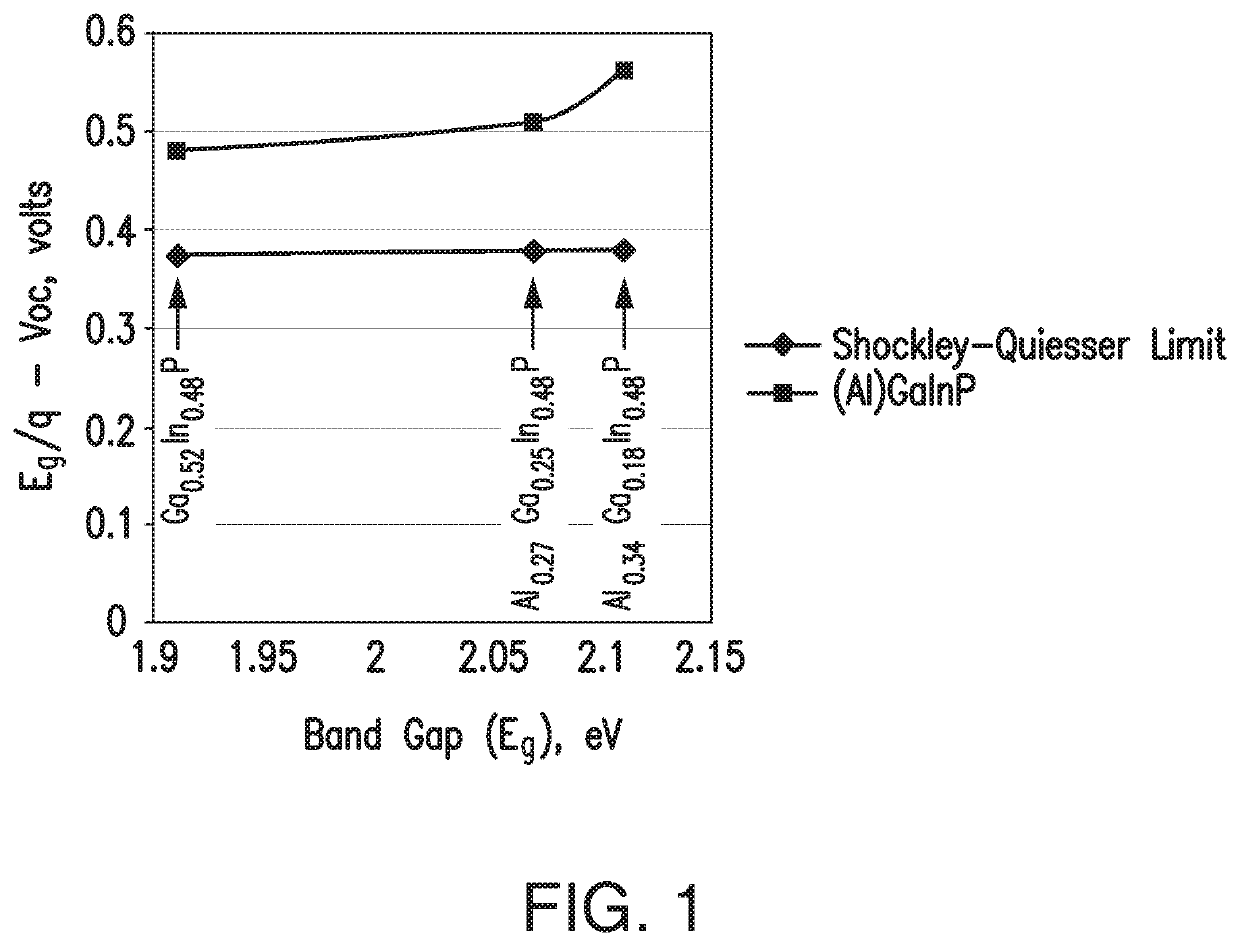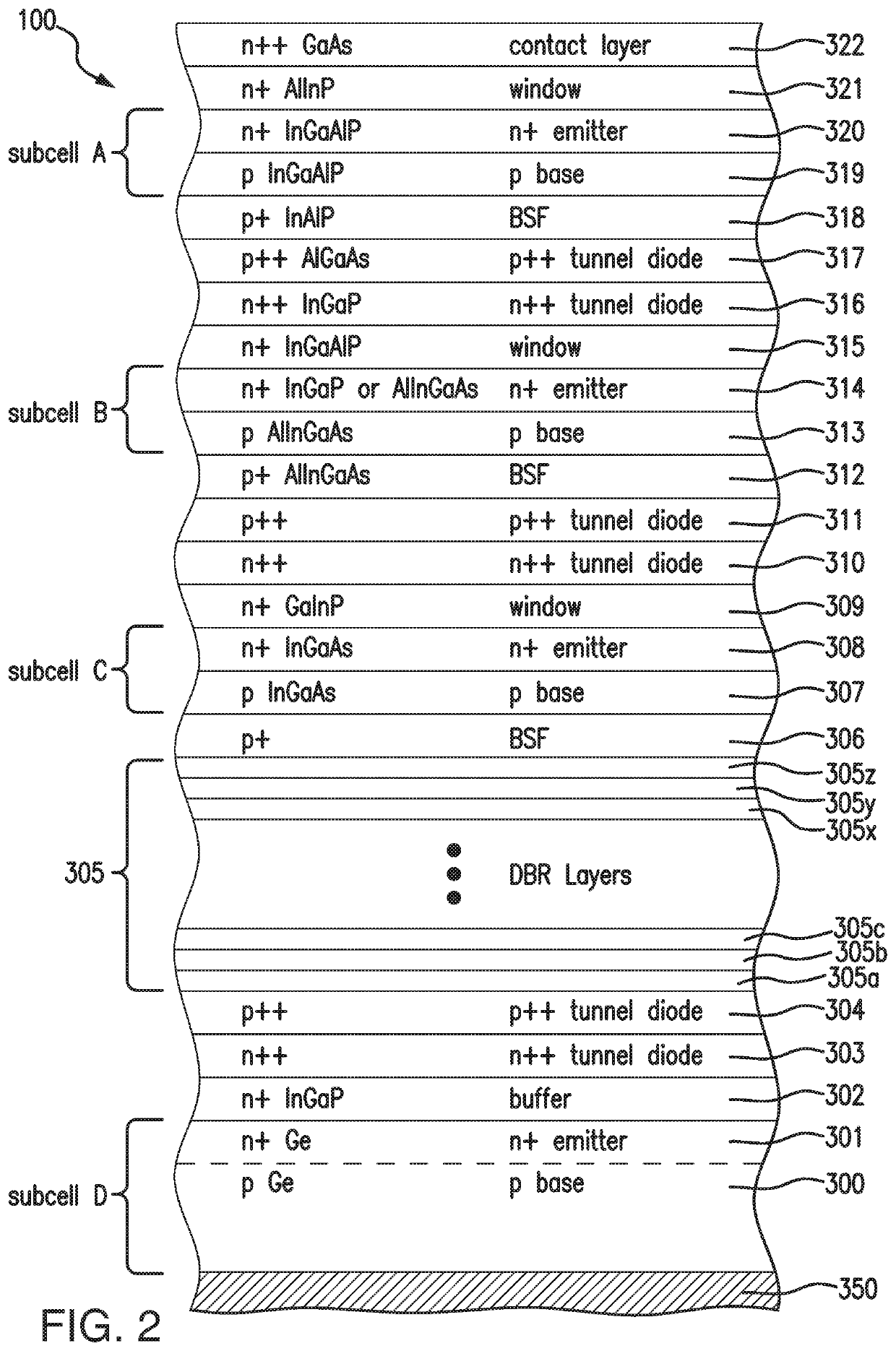Multijunction solar cell and solar cell assemblies for space applications
a solar cell and multi-junction technology, applied in the field of solar cells and the fabrication of solar cells, can solve the problems of increasing the complexity of properly specifying and manufacturing, affecting the efficiency of solar cells, and affecting the performance of solar cells. achieve the effect of optimizing such efficiency, increasing the efficiency of multi-junction solar cells, and increasing photoconversion efficiency
- Summary
- Abstract
- Description
- Claims
- Application Information
AI Technical Summary
Benefits of technology
Problems solved by technology
Method used
Image
Examples
first embodiment
[0166]Turning to the multijunction solar cell device of the present disclosure, FIG. 2 is a cross-sectional view of a four junction solar cell 100 after several stages of fabrication including the growth of certain semiconductor layers on the growth substrate up to the contact layer 322 as presented in to the disclosure of parent application Ser. No. 15 / 873,135 filed Jan. 17, 2018.
[0167]As shown in the illustrated example of FIG. 2, the bottom or fourth subcell D includes a growth substrate 300 formed of p-type germanium (“Ge”) which also serves as a base layer. A back metal contact pad 350 formed on the bottom of base layer 300 provides the bottom p type polarity electrical contact to the multijunction solar cell 100. The bottom subcell D, further includes, for example, a highly doped n-type Ge emitter layer 301, and an n-type indium gallium arsenide (“InGaAs”) nucleation layer 302. The nucleation layer is deposited over the base layer, and the emitter layer 301 is formed in the su...
second embodiment
[0204]FIG. 4B depicts an upright metamorphic multijunction solar cell 400 grown on an n type germanium substrate 390. Although the depicted embodiment is a five junction solar cell with three lattice matched upper subcells A, B, C which are lattice mismatched from lower germanium subcells D and E, in other embodiments there may be two lattice matched upper subcells, and / or one lower germanium subcell. The lattice constant graph on the left-hand side of the Figure depicts the change in lattice constant through the thickness of the solar cell.
[0205]In FIG. 4B various subcells are similar to the structure described and depicted in FIG. 4A and in the interest of brevity, the description of layers 405 to 409, and 306 through 322 will not be repeated here.
[0206]Since in this embodiment, the growth substrate 390 does not include a photovoltaic junction, a tunnel diode consisting of an n++ layer 391 is grown directly over the growth substrate 390, and a p++ layer 392 of the tunnel diode is ...
embodiment 4
[0266]Although the differences in band gap among the various embodiments described above, i.e., of the order of 0.1 to 0.2 eV, may seem relatively small, it is evident that such adjustments result in an increase in the EOL solar cell efficiency from 24.4% as reported in the parent application U.S. patent application Ser. No. 14 / 828,206 filed Aug. 17, 2015 (and corresponding published European Patent Application EP 3 133 650 A1) to 25.7% for the solar cell of embodiment 4 described above, which is certainly a surprising and unexpected improvement that would constitute an “inventive step” over the related configuration described in the parent application and European patent application publication.
[0267]The wide range of electron and proton energies present in the space environment necessitates a method of describing the effects of various types of radiation in terms of a radiation environment which can be produced under laboratory conditions. The methods for estimating solar cell deg...
PUM
| Property | Measurement | Unit |
|---|---|---|
| band gap | aaaaa | aaaaa |
| band gap | aaaaa | aaaaa |
| band gap | aaaaa | aaaaa |
Abstract
Description
Claims
Application Information
 Login to View More
Login to View More - R&D
- Intellectual Property
- Life Sciences
- Materials
- Tech Scout
- Unparalleled Data Quality
- Higher Quality Content
- 60% Fewer Hallucinations
Browse by: Latest US Patents, China's latest patents, Technical Efficacy Thesaurus, Application Domain, Technology Topic, Popular Technical Reports.
© 2025 PatSnap. All rights reserved.Legal|Privacy policy|Modern Slavery Act Transparency Statement|Sitemap|About US| Contact US: help@patsnap.com



